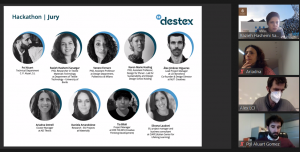The second virtual hackathon organized by DESTEX consortium was held on 11-12th of March. The hackathon addressed the challenge launched by the company C.P. Aluart, member of AEI TÈXTILS, to develop the firefighter protective clothing for 2030.
Firefighting requires comfortable clothing to increase performance and prevent heat exhaustion.
Current firefighting protective garments rely on external layers for fire and heat prevention based on high performance materials. However, those same products are bulky and limit mobility of firefighters. In addition, those layers have poor breathability and may increase the heat fatigue for the firefighter.
The challenge aimed at developing new concepts and ideas for wearing future firefighters taking state-of-the-art technologies and textile materials with innovative designs to keep firefighters comfortable while protected and safe.
|
C.P. Aluart is a company founded in 1993, specialized in the manufacture of fabrics and personal protective clothing using circular knitting technology.
The four universities of DESTEX (LCI , POLIMI , DSKD and UB) recruited students to participate in this second hackathon. In total, 10 students participated in 3 teams to complete the challenge. They worked remotely to develop and deliver a solution within 24 hours.
The different developed solutions were presented on the second day of the hackathon where the jury selected the best concept. The winning team was awarded a free-pass to the DESTEX summer school that will be held in Milan on June 2021.

Pol Aluart Gomez
According to Pol Aluart, co-owner of the company, the participation in this kind of activities provides an added value not only to the company, which obtains an external vision and the generation of new ideas for its business and products, but also for the students from the participating universities, which have the opportunity to apply the acquired knowledge in real cases.
In the first hackathon, held on January 28th and 29, the challenge for students was launched by the company FINSA, also a member of the cluster.
Firefighting requires comfortable clothing in order to increase performance and prevent heat exhaustion. Current firefighting protective garments rely on external layers for fire and heat prevention based on high performance materials. However, those same products are bulky and limit mobility of firefighters. In addition, those layers have poor breathability and may increase the heat fatigue for the firefighter.
The challenge aims to develop new concepts and ideas for wearing future firefighters taking state-of-the-art technologies and textile materials with innovative designs to keep firefighters comfortable while protected and safe. This means from one side to exploit new materials and integrated sensors to improve firefighter performances and work (i.e., sensor to detect human parameters or the environment and give info) and form the other to use materials able to provide a good comfort for their activities (10-15 hours). In the ideation of the new product new manufacturing processes could be considered as well (i.e., 3d printing).
More in details the students are asked to design two possible items:
- Undergarment
- Hood with integrated protection for the shoulders.
Both the items need to be designed by embracing both aesthetics and functionality and have to respect the international standard against fire.
Some key aspects for firefighting clothing are also interior layers (skin-contact), which improved with highly breathable fabrics such as COOLMAX and flame-resistant modifications. These innovations can increase the performance of the overall garment in terms of fire resistance while increasing breathability.
The hackathon is free. To attend the hackathon, you must be student of one of the participating institutions (University of Borås, Sweden; Politecnico di Milano, School of Design, Italy; Design School Kolding, Denmark; LCI Barcelona – Escuela Superior de Diseño y Moda, Spain), enrolled at the time of the Hackathon. The Hackathon is entirely virtual, you would need only to connect from your laptop or computer with a stable internet connection. You can work remotely from your home. To develop and present the design solution you would need the design software you already use. You will work in a team of four students. Participants will be grouped by the Hackathon staff.
|
Destex Project
Advanced Textile Materials is an emerging sector focusing on the technical aspects of textile materials rather than on their aesthetics. In order to foster innovation within this sector, higher education programs need to uptake and reinforce creativity and design aspects into textile engineering programs as driver to unlock the latent innovation potential of advanced textile manufacturing industry. In this context, DESTEX project will develop innovative training tools targeted to higher education students in order to address its objectives:
- To support higher education students to acquire skills in interdisciplinary innovation based on creative and industrial design applied to the textile sector.
- To foster student cooperation in a multidisciplinary approach in work- based projects.
- To provide knowledge, skills and competences using virtual collaboration tools.
- To promote the application of good practices for the enhancement of innovative skills.
Visit the website, for more information: www.destex.eu






